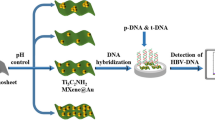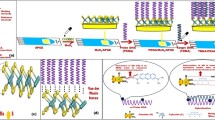Abstract
A TiO2-guanine nanocomposite (TG NC)–based electrochemical biosensor was immobilized with hemagglutinin (HA) gene specific probe with 5ʹ NH2 group on screen-printed gold electrode (probe(ss)DNA-TG-SPGE). The modified biosensor was examined for H1N1 swine flu virus. TG NCs along with precursors were characterized spectroscopically and morphologically by employing several approaches. Electrochemical investigations were performed with the help of cyclic voltammetric (CV) and electrochemical impedance spectroscopy (EIS) in 0.1 M phosphate buffer saline (PBS; pH 7.4) with 1 µM methylene blue (MB) redox indicator. For better detection of single-stranded virus DNA, the modified electrode was optimized at various concentrations, pH, and scan rates. The modified biosensor showed high sensitivity (40.32 μA/ng.cm2), low LOD (0.00024 ng/6 µL), and broad linear range 0.0002–20 ng/6µL with coefficient of determination of R2=0.9981 for H1N1 virus detection. The HA gene–modified biosensor presented decent stability and specificity against different infectious pathogens including H3N2 virus and human DNA with negative response. Furthermore, the modified biosensor also responded well for real sample target DNA detection with a recovery of >96%. The simply designed HA gene–modified biosensor transduces decreased current response towards target-specific (ss)DNA binding and could be used as a rapid detection tool for H1N1 swine flu virus diagnosis.
Graphical abstract











Similar content being viewed by others
Data Availability
The authors declare that the data supporting the findings of this study are available within the paper and its Supplementary Information files. Should any raw data files be needed in another format they are available from the corresponding author upon reasonable request. Source data are provided with this paper.
References
Park G, Kim HO, Lim JW, Park C, Yeom M, Song D, Haam S (2022) Rapid detection of influenza A (H1N1) virus by conductive polymer-based nanoparticle via optical response to virus-specific binding. Nano Res. 15:2254–2262. https://doi.org/10.1007/s12274-021-3772-6
Ravina, Dalal A, Mohan H, Prasad M, Pundir CS (2020) Detection methods for influenza A H1N1 virus with special reference to biosensors: a review. Biosci Rep 40. https://doi.org/10.1042/BSR20193852
Singhal C, Khanuja M, Chaudhary N, Pundir CS, Narang J (2018) Detection of chikungunya virus DNA using two-dimensional MoS2 nanosheets based disposable biosensor. Sci Rep 8. https://doi.org/10.1038/s41598-018-25824-8
Li J, Lin R, Yang Y, Zhao R, Song S, Zhou Y, Shi J, Wang L, Song H, Hao R (2021) Multichannel immunosensor platform for the rapid detection of SARS-CoV-2 and influenza A(H1N1) virus. ACS Appl Mater Interfaces 13:22262–22270. https://doi.org/10.1021/acsami.1c05770
Park JA, Kim J, Kim SM, Sohn H, Park C, Kim TH, Lee JH, Lee MH, Lee T (2021) Fabrication of electrochemical influenza virus (H1N1) biosensor composed of multifunctional DNA four-way junction and molybdenum disulfide hybrid material. Materials 14:1–12. https://doi.org/10.3390/ma14020343
Ghaffari H, Tavakoli A, Moradi A, Tabarraei A, Bokharaei-Salim F, Zahmatkeshan M, Farahmand M, Javanmard D, Kiani SJ, Esghaei M, Pirhajati-Mahabadi V, Ataei-Pirkooh A, Monavari SH (2019) Inhibition of H1N1 influenza virus infection by zinc oxide nanoparticles: another emerging application of nanomedicine. J Biomed Sci 26. https://doi.org/10.1186/s12929-019-0563-4
Torres C, Ellamathy J, Berrojo I, Liu Y, Gkountana GV, Kühne P, Sebastián J, Jovanovic I, Bern D, Nandi S, Lüftner M, Langwallner V, Lysandrou M, Taylor S, Martinovic K, Atif A-R, Manouchehri E, Kamali-Moghaddam M, Mestres G. Developing an electrochemical biosensor for the detection of hemagglutinin protein of influenza A virus subtype H1N1 in artificial saliva †, (2021) 1–15. https://doi.org/10.3390/xxxxx
Kumar R, Nayak M, Sahoo GC, Pandey K, Sarkar MC, Ansari Y, Das VN, Topno RK, Madhukar M, Das P (2019) Iron oxide nanoparticles based antiviral activity of H1N1 influenza A virus. J Infect Chemother 25:325–329
Lee H-E, Kang YO, Choi S-H (2014) Electrochemical-DNA biosensor development based on a modified carbon electrode with gold nanoparticles for influenza A (H1N1) detection: effect of spacer. Int J Electrochem Sci 9:6793–6808. https://www.electrochemsci.org
Song S, Ha K, Guk K, Hwang SG, Choi JM, Kang T, Bae P, Jung J, Lim EK (2016) Colorimetric detection of influenza A (H1N1) virus by a peptide-functionalized polydiacetylene (PEP-PDA) nanosensor. RSC Adv. 6:48566–48570. https://doi.org/10.1039/c6ra06689e
Ravina A, Dalal PS, Gill J, Narang M, Prasad H (2020) Mohan, Genosensor for rapid, sensitive, specific point-of-care detection of H1N1 influenza (swine flu). Process Biochemistry 98:262–268. https://doi.org/10.1016/j.procbio.2020.09.016
Ravina H, Mohan PS, Gill A (2019) Kumar, Hemagglutinin gene based biosensor for early detection of swine flu (H1N1) infection in human. Int J Biol Macromol 130:720–726. https://doi.org/10.1016/j.ijbiomac.2019.02.149
Yadav M, Singh G, Lata S (2022) Revisiting some recently developed conducting polymer@metal oxide nanostructures for electrochemical sensing of vital biomolecules: a review. J Anal Test. https://doi.org/10.1007/s41664-022-00209-z
Dhanda M, Arora R, Saini M, Nehra SP, Lata S (2022) Prolific intercalation of VO2 (D)/polypyrrole/g-C 3 N 4 as an energy storing electrode with remarkable capacitance. New J Chem. https://doi.org/10.1039/D2NJ02401B
Yadav M, Singh G, Lata S (2022) Polyvinylpyrrolidone/TiO2 composites’ preparation via sol–gel procedure furthered with non-enzymatic glucose sensing and antibacterial effectiveness. Environ Sci Pollut Res. https://doi.org/10.1007/s11356-022-21558-3
Yadav M, Singh G, Lata S (2022) Sol–gel-assisted synthesis of PVPO-TiO2 nanocomposites extended to bifunctionality as efficient electrode for enzymeless D-(+)-glucose sensing and antimicrobial potential. J Solid State Electrochem. https://doi.org/10.1007/s10008-022-05216-9
Dhanda M, Nehra SP, Lata S (2022) The amalgamation of g-C3N4 and VO2 (D) as a facile electrode for enhanced storage of energy. Synth Met 286:117046. https://doi.org/10.1016/j.synthmet.2022.117046
Song K, Lin J, Zhuang Y, Han Z, Chen J (2021) Construction of photoelectrochemical DNA biosensors based on TiO2 @carbon dots@black phosphorous quantum dots. Micromachines (Basel) 12. https://doi.org/10.3390/mi12121523
Yadav M, Arora R, Dhanda M et al (2023) Ppy/TiO2-SiO2 nanohybrid series: synthesis, characterization, photocatalytic activity, and antimicrobial potentiality. J Environ Health Sci Engineer 21:239–254. https://doi.org/10.1007/s40201-023-00858-x
Agnihotri AS, Varghese ANM (2021) Transition metal oxides in electrochemical and bio sensing: a state-of-art review. Appl Surf Sci Adv 4. https://doi.org/10.1016/j.apsadv.2021.100072.
Yadav M, Dhanda M, Arora R et al (2023) Dual applicability of ceria and silica nanospheres (CeO2@SiO2 NSs) assembled with pencil graphite electrode to sense ascorbic acid, extended with their antibacterial property. Mater Sci Eng: B 297:116719. https://doi.org/10.1016/j.mseb.2023.116719
Ravina Gill PS, Narang J et al (2022) Development of amperometric biosensor based on cloned hemagglutinin gene of H1N1 (swine flu) virus. 3 Biotech 12:141. https://doi.org/10.1007/s13205-022-03200-8
Yadav M, Dhanda M, Arora R, Jagdish R, Singh G, Lata S (2022) Titania (TiO2)/silica (SiO2) nanospheres or NSs amalgamated on a pencil graphite electrode to sense L-ascorbic acid electrochemically and augmented NSs for antimicrobial behaviour. New J Chem. https://doi.org/10.1039/D2NJ01892F
Huertas CS, Soler M, Estevez MC, Lechuga LM (2020) One-step immobilization of antibodies and DNA on gold sensor surfaces via a poly-adenine oligonucleotide approach. Anal Chem 92:12596–12604. https://doi.org/10.1021/acs.analchem.0c02619
Chandraboss VL, Karthikeyan B, Senthilvelan S (2015) Experimental and first-principles investigation of the adsorption and entrapping of guanine with SiO2 clusters of sol-gel silicate material for understanding DNA photodamage. Phys Chem Chem Physics 17:12100–12114. https://doi.org/10.1039/c5cp00451a
Song G, Gao Y, Wu H, Hou W, Zhang C, Ma H (2012) Physiological effect of anatase TiO2 nanoparticles on Lemna minor. Environ Toxicol Chem 31:2147–2152. https://doi.org/10.1002/etc.1933
Arun Kumar D, Merline Shyla J, Xavier FP (2012) Synthesis, and characterization of TiO2/SiO2 nano composites for solar cell applications. Appl Nanosci (Switzerland) 2:429–436. https://doi.org/10.1007/s13204-012-0060-5
Lusvardi G, Barani C, Giubertoni F, Paganelli G (2017) Synthesis and characterization of TiO2 nanoparticles for the reduction of water pollutants. Materials 10. https://doi.org/10.3390/ma10101208
Khanna PK, Singh N, Charan S (2007) Synthesis of nano-particles of anatase-TiO2 and preparation of its optically transparent film in PVA. Mater Lett 61:4725–4730. https://doi.org/10.1016/j.matlet.2007.03.064
Kundu J, Neumann O, Janesko BG, Zhang D, Lal S, Barhoumi A, Scuseria GE, Halas NJ (2009) Adenine-and adenosine monophosphate (AMP)-gold binding interactions studied by surface-enhanced Raman and infrared spectroscopies. J Physical Chem C. 113:14390–14397. https://doi.org/10.1021/jp903126f
Biris AR, Pruneanu S, Pogacean F, Lazar MD, Borodi G, Ardelean S, Dervishi E, Watanabe F, Biris AS (2013) Few-layer graphene sheets with embedded gold nanoparticles for electrochemical analysis of adenine. Int J Nanomed 8:1429–1438. https://doi.org/10.2147/IJN.S42613
Bukkitgar SD, Shetti NP (2017) Fabrication of a TiO2 and clay nanoparticle composite electrode as a sensor. Anal Methods 9:4387–4393. https://doi.org/10.1039/c7ay01068k
Dhanda M, Nehra SP, Lata S (2023) Synthesizing GCN–xAg composites and studying their role as electrochemical pseudo-supercapacitor electrode. Russ J Electrochem 59:248–261. https://doi.org/10.1134/S1023193523030047
Al-mokaram AMAAA, Yahya R, Abdi MM, Nabi H, Ekramul M (n.d.) The development of non-enzymatic glucose biosensors based on electrochemically prepared polypyrrole – chitosan – titanium dioxide nanocomposite films. https://doi.org/10.3390/nano7060129
Govindaraj R, Pandian SM, Ramasamy P, Mukhopadhyay S (2015) Sol-gel synthesized mesoporous anatase titanium dioxide nanoparticles for dye sensitized solar cell (DSSC) applications. Bull Mater Sci 38:291–296. https://doi.org/10.1007/s12034-015-0874-3
Acknowledgements
The authors are obligated to CSIR, New Delhi, India, for providing fellowship to Meena Yadav as SRF (award letter no. 09/1063(0028)/2019-EMR-I), University Grant Commission, Delhi, for providing fellowship to Monika Dhanda as JRF (Ref. No. 201610158088), Deenbandhu Chhotu Ram University of Science and Technology, Murthal, Sonipat, Haryana, and Maharshi Dayanand University, Rohtak, Haryana, for providing necessary facilities.
Author information
Authors and Affiliations
Corresponding authors
Ethics declarations
Conflict of interest
The authors declare no competing interests.
Ethical approval
Institutional Human Ethics committee approval for this study has been obtained vide letter no. HEC/2019/77 dated 10.07.2019.
Additional information
Publisher's Note
Springer Nature remains neutral with regard to jurisdictional claims in published maps and institutional affiliations.
Highlights
• Synthesis of novel TiO2-guanine-based nanocomposites by a simple and facile sol-gel method.
• Electrochemical sensing of HA gene specific probe-ssDNA–modified screen-printed gold electrode for H1N1 influenza virus.
• The sensor exhibited high sensitivity, low detection limit (0.00024 ng/6 µL), and wide linear range (0.0002–20 ng/6µL).
• Moreover, the sensor exhibited high specificity against H3N2 influenza strain, various pathogens, and human DNA.
• The modified genosensor also exposed good storage stability of 93.1% even after 90 days of storing at 4 °C.
Supplementary Information
Below is the link to the electronic supplementary material.
Rights and permissions
Springer Nature or its licensor (e.g. a society or other partner) holds exclusive rights to this article under a publishing agreement with the author(s) or other rightsholder(s); author self-archiving of the accepted manuscript version of this article is solely governed by the terms of such publishing agreement and applicable law.
About this article
Cite this article
Yadav, M., Arora, R., Dhanda, M. et al. TiO2-guanine as a new amalgamation compound for fabrication of a disposable biosensor with high sensitivity and rapid detection of H1N1 swine flu virus. Microchim Acta 190, 412 (2023). https://doi.org/10.1007/s00604-023-05984-9
Received:
Accepted:
Published:
DOI: https://doi.org/10.1007/s00604-023-05984-9




